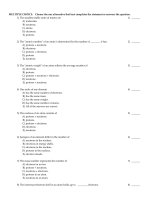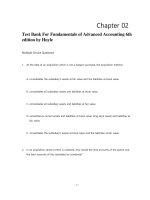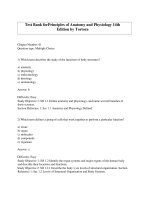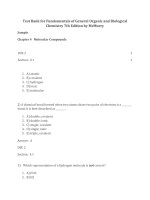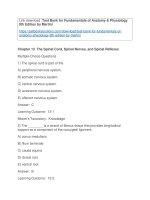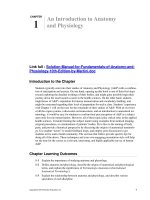Test bank for fundamentals of anatomy and physiology 11e c04
Bạn đang xem bản rút gọn của tài liệu. Xem và tải ngay bản đầy đủ của tài liệu tại đây (200.47 KB, 30 trang )
Chapterȱ4
TheȱTissueȱLevelȱofȱOrganization
Multiple Choice Questions
1) Whichȱstatementȱaboutȱtissuesȱisȱcorrect?
A) Tissuesȱareȱalwaysȱinȱtheȱformȱofȱsheetsȱofȱcells.
B) Allȱtheȱorgansȱofȱanȱorganȱsystemȱareȱcomposedȱofȱaȱsingleȱtissueȱtype.
C) Aȱtissueȱisȱcomposedȱofȱaȱsingleȱtypeȱofȱcell.
D) Anȱorganȱcombinesȱseveralȱdifferentȱtissues.
E) Tissuesȱareȱmicroscopic,ȱandȱinvisibleȱtoȱtheȱnakedȱeye.
Answer: D
LearningȱOutcome: 4-1
BloomȇsȱTaxonomy: Understanding
2) Whereȱisȱtheȱtissueȱlevelȱofȱorganization?
A) betweenȱcellsȱandȱorgans
B) betweenȱorganellesȱandȱcells
C) betweenȱorgansȱandȱorganȱsystems
D) betweenȱatomsȱandȱmolecules
E) betweenȱmoleculesȱandȱorganelles
Answer: A
LearningȱOutcome: 4-1
BloomȇsȱTaxonomy: Understanding
3) Theȱstudyȱofȱtissuesȱisȱcalled
A) cytology.
B) toxicology.
C) microbiology.
D) histology.
E) mycology.
Answer: D
LearningȱOutcome: 4-1
BloomȇsȱTaxonomy: Remembering
4) Whichȱoneȱofȱtheȱfollowingȱisȱnot oneȱofȱtheȱfourȱmainȱtissueȱcategories?
A) muscleȱtissue
B) neuralȱtissue
C) osseousȱtissue
D) connectiveȱtissue
E) epithelialȱtissue
Answer: C
LearningȱOutcome: 4-1
BloomȇsȱTaxonomy: Remembering
Copyrightȱ©ȱ2018ȱPearsonȱEducation,ȱInc.
108ȱȱȱTestȱBankȱforȱFundamentalsȱofȱAnatomyȱ&ȱPhysiology,ȱ11e
5) Whichȱofȱtheȱfourȱbasicȱtissueȱtypesȱformȱcoveringsȱorȱliningsȱofȱorgans?
A) muscleȱtissue
B) epithelialȱtissue
C) protectiveȱtissue
D) neuralȱtissue
E) connectiveȱtissue
Answer: B
LearningȱOutcome: 4-1
BloomȇsȱTaxonomy: Remembering
6) Neuralȱtissue
A) carriesȱinformationȱfromȱoneȱpartȱofȱtheȱbodyȱtoȱanother.
B) canȱcontract.
C) fillsȱspacesȱinȱtheȱbody.
D) storesȱenergy.
E) formsȱglands.
Answer: A
LearningȱOutcome: 4-1
BloomȇsȱTaxonomy: Remembering
7) Anyȱsubstanceȱthatȱentersȱorȱleavesȱyourȱbodyȱmustȱcross
A) muscleȱtissue.
B) connectiveȱtissue.
C) secretoryȱtissue.
D) neuralȱtissue.
E) epithelialȱtissue.
Answer: E
LearningȱOutcome: 4-2
BloomȇsȱTaxonomy: Remembering
8) Theȱtissueȱthatȱalwaysȱhasȱanȱapicalȱandȱaȱbasalȱsurfaceȱisȱ________ȱtissue.
A) epithelial
B) connective
C) muscle
D) basal
E) apical
Answer: A
LearningȱOutcome: 4-2
BloomȇsȱTaxonomy: Understanding
9) Characteristicsȱofȱepitheliaȱincludeȱallȱofȱtheȱfollowingȱexcept
A) attachment.
B) avascularity.
C) regeneration.
D) polarity.
E) extracellularȱmatrix.
Answer: E
LearningȱOutcome: 4-2
BloomȇsȱTaxonomy: Remembering
Copyrightȱ©ȱ2018ȱPearsonȱEducation,ȱInc.
Chapterȱ4ȱȱTheȱTissueȱLevelȱofȱOrganizationȱȱȱ109
10) Epithelialȱcellsȱthatȱlineȱtheȱsmallȱintestineȱtransportȱnutrientsȱintoȱtheȱbody.ȱDirectional
transportȱisȱassociatedȱwithȱtheȱepithelialȱtissueȱpropertyȱof
A) avascularity.
B) regeneration.
C) cellularity.
D) polarity.
E) attachment.
Answer: D
LearningȱOutcome: 4-2
BloomȇsȱTaxonomy: Applying
11) Epithelialȱcellsȱthatȱareȱadaptedȱforȱabsorptionȱusuallyȱhaveȱ________ȱatȱtheirȱfreeȱsurface.
A) mitochondria
B) cilia
C) microvilli
D) junctionalȱcomplexes
E) Golgiȱcomplexes
Answer: C
LearningȱOutcome: 4-2
BloomȇsȱTaxonomy: Understanding
12) Closeȱexaminationȱofȱaȱhealthyȱorganȱrevealsȱaȱliningȱofȱseveralȱlayersȱofȱcells.ȱTheȱlayersȱdo
notȱcontainȱanyȱbloodȱvesselsȱandȱoneȱsurfaceȱofȱtheȱcellsȱlinesȱtheȱcavityȱofȱtheȱorgan.ȱThis
tissueȱisȱaȱtypeȱof
A) epithelium.
B) muscleȱtissue.
C) connectiveȱtissue.
D) neuralȱtissue.
E) fatȱtissue.
Answer: A
LearningȱOutcome: 4-2
BloomȇsȱTaxonomy: Applying
13) Anȱepithelialȱcellȱcanȱbeȱdividedȱintoȱtwoȱfunctionalȱregions.ȱTheyȱareȱtheȱ________ȱandȱthe
basalȱsurface.
A) apical
B) pinnacle
C) topical
D) crest
E) apogeal
Answer: A
LearningȱOutcome: 4-2
BloomȇsȱTaxonomy: Remembering
Copyrightȱ©ȱ2018ȱPearsonȱEducation,ȱInc.
110ȱȱȱTestȱBankȱforȱFundamentalsȱofȱAnatomyȱ&ȱPhysiology,ȱ11e
14) Theȱjunctionȱtypeȱthatȱletsȱneighboringȱcellsȱexchangeȱsmallȱmoleculesȱisȱthe
A) desmosome.
B) hemidesmosome.
C) gapȱjunction.
D) tightȱjunction.
E) zonulaȱadherens.
Answer: C
LearningȱOutcome: 4-2
BloomȇsȱTaxonomy: Remembering
15) Aȱtypeȱofȱintercellularȱjunctionȱthatȱstopsȱmaterialsȱfromȱcrossingȱanȱepitheliumȱbetweenȱcells
isȱcalledȱa(n)
A) tightȱjunction.
B) gapȱjunction.
C) intermediateȱjunction.
D) desmosome.
E) hemidesmosome.
Answer: A
LearningȱOutcome: 4-2
BloomȇsȱTaxonomy: Remembering
16) DeadȱskinȱcellsȱareȱshedȱinȱthinȱsheetsȱbecauseȱtheyȱareȱheldȱtogetherȱbyȱȈspotsȈȱof
proteoglycanȱreinforcedȱbyȱintermediateȱfilaments.ȱSuchȱstrongȱintercellularȱconnectionsȱare
called
A) gapȱjunctions.
B) intermediateȱjunctions.
C) tightȱjunctions.
D) desmosomes.
E) junctionalȱcomplexes.
Answer: D
LearningȱOutcome: 4-2
BloomȇsȱTaxonomy: Remembering
17) ________ȱareȱproteinsȱthatȱconnectȱadjacentȱcellsȱatȱaȱgapȱjunction.
A) Bindins
B) Adhesions
C) Connexins
D) Attachons
E) Tieons
Answer: C
LearningȱOutcome: 4-2
BloomȇsȱTaxonomy: Remembering
Copyrightȱ©ȱ2018ȱPearsonȱEducation,ȱInc.
Chapterȱ4ȱȱTheȱTissueȱLevelȱofȱOrganizationȱȱȱ111
18) Inȱstratifiedȱepitheliaȱadaptedȱtoȱresistȱmechanicalȱforces,ȱwhichȱofȱtheȱfollowingȱtypesȱof
cell-to-cellȱjunctionsȱareȱespeciallyȱabundant?
A) tightȱjunctions
B) basolateralȱjunctions
C) gapȱjunctions
D) hemidesmosomes
E) desmosomes
Answer: E
LearningȱOutcome: 4-2
BloomȇsȱTaxonomy: Understanding
19) Epitheliumȱisȱconnectedȱtoȱunderlyingȱconnectiveȱtissueȱby
A) keratin.
B) interfacialȱcanals.
C) aȱbasementȱmembrane.
D) aȱreticularȱlamina.
E) proteoglycan.
Answer: C
LearningȱOutcome: 4-2
BloomȇsȱTaxonomy: Remembering
20) Germinativeȱcells
A) startȱinȱtheȱsuperficialȱlayersȱofȱepithelialȱtissue.
B) cannotȱdivideȱinȱtheȱdeepȱlayersȱofȱepithelialȱtissue.
C) makeȱupȱmostȱofȱtheȱepithelialȱtypeȱofȱtissue.
D) divideȱcontinuallyȱtoȱproduceȱnewȱepithelialȱcells.
E) cannotȱfunctionȱinȱtheȱrepairȱofȱepithelialȱtissue.
Answer: D
LearningȱOutcome: 4-2
BloomȇsȱTaxonomy: Understanding
21) Cellsȱthatȱareȱflatȱandȱthinȱareȱclassifiedȱas
A) columnar.
B) squamous.
C) blasts.
D) transitional.
E) cuboidal.
Answer: B
LearningȱOutcome: 4-3
BloomȇsȱTaxonomy: Remembering
22) Theȱtwoȱmajorȱtypesȱofȱcellȱlayeringȱinȱepitheliaȱare
A) simpleȱandȱproper.
B) stratifiedȱandȱpseudostratified.
C) squamousȱandȱsimple.
D) simpleȱandȱstratified.
E) cuboidalȱandȱcolumnar.
Answer: D
LearningȱOutcome: 4-3
BloomȇsȱTaxonomy: Remembering
Copyrightȱ©ȱ2018ȱPearsonȱEducation,ȱInc.
112ȱȱȱTestȱBankȱforȱFundamentalsȱofȱAnatomyȱ&ȱPhysiology,ȱ11e
23) Theȱepitheliumȱthatȱlinesȱtheȱbodyȱcavitiesȱisȱknownȱas
A) perithelium.
B) myothelium.
C) intrathelium.
D) endothelium.
E) mesothelium.
Answer: E
LearningȱOutcome: 4-3
BloomȇsȱTaxonomy: Remembering
24) Theȱepitheliaȱthatȱlineȱbodyȱcavitiesȱandȱbloodȱvesselsȱareȱclassifiedȱas
A) simpleȱsquamous.
B) stratifiedȱsquamous.
C) simpleȱcuboidal.
D) stratifiedȱcuboidal.
E) transitional.
Answer: A
LearningȱOutcome: 4-3
BloomȇsȱTaxonomy: Remembering
25) Anȱexampleȱofȱkeratinizedȱstratifiedȱsquamousȱepitheliumȱwouldȱbe
A) exposedȱskin.
B) airȱsacsȱofȱtheȱlungs.
C) theȱliningȱofȱtheȱanus.
D) theȱouterȱcoveringȱofȱtheȱintestines.
E) theȱliningȱofȱtheȱoralȱcavity.
Answer: A
LearningȱOutcome: 4-3
BloomȇsȱTaxonomy: Understanding
26) Theȱfunctionȱofȱsimpleȱcuboidalȱepitheliumȱis
A) supportȱandȱstructure.
B) protectionȱandȱtransport.
C) phagocytosisȱandȱimmunity.
D) absorptionȱandȱsecretion.
E) storageȱandȱretrieval.
Answer: D
LearningȱOutcome: 4-3
BloomȇsȱTaxonomy: Remembering
27) Whichȱtissueȱlinesȱtheȱsmallȱintestineȱandȱtheȱstomach?
A) simpleȱsquamousȱepithelium
B) simpleȱcuboidalȱepithelium
C) simpleȱcolumnarȱepithelium
D) pseudostratifiedȱciliatedȱcolumnarȱepithelium
E) stratifiedȱsquamousȱepithelium
Answer: C
LearningȱOutcome: 4-3
BloomȇsȱTaxonomy: Remembering
Copyrightȱ©ȱ2018ȱPearsonȱEducation,ȱInc.
Chapterȱ4ȱȱTheȱTissueȱLevelȱofȱOrganizationȱȱȱ113
28) Transitionalȱepitheliumȱisȱfound
A) liningȱtheȱurinaryȱbladder.
B) liningȱtheȱductsȱthatȱdrainȱsweatȱglands.
C) liningȱkidneyȱtubules.
D) liningȱtheȱstomach.
E) atȱtheȱsurfaceȱofȱtheȱskin.
Answer: A
LearningȱOutcome: 4-3
BloomȇsȱTaxonomy: Remembering
29) Youȱwouldȱfindȱpseudostratifiedȱcolumnarȱepitheliumȱliningȱthe
A) trachea.
B) urinaryȱbladder.
C) secretoryȱportionsȱofȱtheȱpancreas.
D) surfaceȱofȱtheȱskin.
E) stomach.
Answer: A
LearningȱOutcome: 4-3
BloomȇsȱTaxonomy: Remembering
30) TheȱPapȱtestȱforȱcervicalȱcancerȱutilizes
A) histology.
B) physiology.
C) anatomy.
D) embryology.
E) exfoliativeȱcytology.
Answer: E
LearningȱOutcome: 4-3
BloomȇsȱTaxonomy: Understanding
31) Glandȱcellsȱproduce
A) mesenchyme.
B) antibodies.
C) secretions.
D) phagocytes.
E) fibers.
Answer: C
LearningȱOutcome: 4-3
BloomȇsȱTaxonomy: Remembering
32) Glandsȱthatȱsecreteȱhormonesȱintoȱtheȱinterstitialȱfluidȱareȱ________ȱglands.
A) endocrine
B) interstitial
C) exocrine
D) merocrine
E) holocrine
Answer: A
LearningȱOutcome: 4-3
BloomȇsȱTaxonomy: Remembering
Copyrightȱ©ȱ2018ȱPearsonȱEducation,ȱInc.
114ȱȱȱTestȱBankȱforȱFundamentalsȱofȱAnatomyȱ&ȱPhysiology,ȱ11e
33) Theȱpancreasȱproducesȱ________ȱsecretionsȱthatȱincludeȱdigestiveȱenzymesȱandȱhormones,
respectively.
A) serousȱandȱsebaceous
B) mucousȱandȱacid
C) merocrineȱandȱholocrine
D) exocrineȱandȱendocrine
E) secretoryȱandȱabsorptive
Answer: D
LearningȱOutcome: 4-3
BloomȇsȱTaxonomy: Understanding
34) Unicellularȱexocrineȱglandsȱsecrete
A) milk.
B) sweat.
C) mucus.
D) sebum.
E) insulin.
Answer: C
LearningȱOutcome: 4-3
BloomȇsȱTaxonomy: Understanding
35) Aȱglandȱformedȱbyȱcellsȱarrangedȱinȱaȱoneȱblindȱpocketȱwithȱaȱsingleȱunbranchedȱductȱwould
beȱcalled
A) simpleȱtubular.
B) simpleȱbranchedȱtubular.
C) compoundȱtubular.
D) compoundȱalveolar.
E) tubuloalveolar.
Answer: A
LearningȱOutcome: 4-3
BloomȇsȱTaxonomy: Understanding
36) Whichȱofȱtheȱfollowingȱglandsȱhaveȱaȱcompoundȱratherȱthanȱaȱsimpleȱstructure?
A) salivaryȱglands
B) sebaceousȱglands
C) mucousȱglands
D) sweatȱglands
E) gastricȱglands
Answer: A
LearningȱOutcome: 4-3
BloomȇsȱTaxonomy: Remembering
Copyrightȱ©ȱ2018ȱPearsonȱEducation,ȱInc.
Chapterȱ4ȱȱTheȱTissueȱLevelȱofȱOrganizationȱȱȱ115
37) Glandsȱthatȱsecreteȱtheirȱproductȱbyȱtheȱburstingȱofȱcellsȱareȱ________ȱglands.
A) apocrine
B) sudoriferous
C) holocrine
D) endocrine
E) merocrine
Answer: C
LearningȱOutcome: 4-3
BloomȇsȱTaxonomy: Remembering
38) Theȱprocessȱofȱlactationȱ(milkȱproduction)ȱdependsȱonȱbothȱmerocrineȱandȱ________ȱsecretion
byȱmammaryȱglandȱepithelialȱcells.
A) epicrine
B) eccrine
C) holocrine
D) apocrine
E) endocrine
Answer: D
LearningȱOutcome: 4-3
BloomȇsȱTaxonomy: Understanding
39) Glandsȱwhoseȱsecretionsȱcontainȱmucinsȱareȱclassifiedȱas
A) serousȱglands.
B) compoundȱglands.
C) mucousȱglands.
D) mixedȱglands.
E) endocrineȱglands.
Answer: C
LearningȱOutcome: 4-3
BloomȇsȱTaxonomy: Understanding
40) Epithelialȱtissueȱisȱalwaysȱattachedȱtoȱwhichȱotherȱmajorȱtissueȱtype?
A) neuralȱtissue
B) membraneȱtissue
C) fascialȱtissue
D) muscleȱtissue
E) connectiveȱtissue
Answer: E
LearningȱOutcome: 4-4
BloomȇsȱTaxonomy: Understanding
41) Theȱcombinationȱofȱfibersȱandȱgroundȱsubstanceȱinȱsupportingȱconnectiveȱtissuesȱisȱknownȱas
A) collagen.
B) cartilage.
C) chondroitin.
D) matrix.
E) scaffold.
Answer: D
LearningȱOutcome: 4-4
BloomȇsȱTaxonomy: Remembering
Copyrightȱ©ȱ2018ȱPearsonȱEducation,ȱInc.
116ȱȱȱTestȱBankȱforȱFundamentalsȱofȱAnatomyȱ&ȱPhysiology,ȱ11e
42) Theȱthreeȱcategoriesȱofȱconnectiveȱtissuesȱare
A) connectiveȱtissueȱproper,ȱfluidȱconnectiveȱtissue,ȱandȱsupportingȱconnectiveȱtissue.
B) epithelialȱconnectiveȱtissue,ȱmuscleȱconnectiveȱtissue,ȱandȱneuralȱconnectiveȱtissue.
C) glandularȱconnectiveȱtissue,ȱexocrineȱconnectiveȱtissue,ȱandȱendocrineȱconnectiveȱtissue.
D) connectiveȱtissueȱproper,ȱcartilageȱconnectiveȱtissue,ȱandȱboneȱconnectiveȱtissue.
E) areolarȱconnectiveȱtissue,ȱadiposeȱconnectiveȱtissue,ȱandȱdenseȱconnectiveȱtissue.
Answer: A
LearningȱOutcome: 4-4
BloomȇsȱTaxonomy: Remembering
43) Whichȱtissueȱisȱcorrectlyȱpairedȱwithȱitsȱcategoryȱofȱconnectiveȱtissue?
A) boneNconnectiveȱtissueȱproper
B) fatNsupportingȱconnectiveȱtissue
C) lymphNfluidȱconnectiveȱtissue
D) cartilageNfluidȱconnectiveȱtissue
E) tendonNsupportingȱconnectiveȱtissue
Answer: C
LearningȱOutcome: 4-4
BloomȇsȱTaxonomy: Remembering
44) WhichȱofȱtheȱfollowingȱtissuesȱareȱclassifiedȱasȱȈconnectiveȱtissueȱproperȈ?
1.ȱareolarȱconnectiveȱtissue
2.ȱadiposeȱtissue
3.ȱfibrocartilage
4.ȱdenseȱirregularȱconnectiveȱtissue
A) 3ȱandȱ4
B) 1,ȱ2,ȱandȱ3
C) 1ȱandȱ2
D) 1,ȱ2,ȱandȱ4
E) 1ȱandȱ3
Answer: D
LearningȱOutcome: 4-4
BloomȇsȱTaxonomy: Remembering
45) Bloodȱisȱwhichȱtypeȱofȱtissue?
A) mesenchyme
B) nerve
C) epithelial
D) muscle
E) connective
Answer: E
LearningȱOutcome: 4-4
BloomȇsȱTaxonomy: Remembering
Copyrightȱ©ȱ2018ȱPearsonȱEducation,ȱInc.
Chapterȱ4ȱȱTheȱTissueȱLevelȱofȱOrganizationȱȱȱ117
46) Whichȱofȱtheȱfollowingȱconnectiveȱtissueȱcellsȱproducesȱcollagen?
A) adipocytes
B) fibroblasts
C) macrophages
D) mastȱcells
E) lymphocytes
Answer: B
LearningȱOutcome: 4-5
BloomȇsȱTaxonomy: Remembering
47) Cellsȱthatȱstoreȱfatȱareȱcalled
A) fibrocytes.
B) macrocytes.
C) adipocytes.
D) podocytes.
E) melanocytes.
Answer: C
LearningȱOutcome: 4-5
BloomȇsȱTaxonomy: Remembering
48) Cellsȱthatȱrespondȱtoȱinjuryȱbyȱdividingȱtoȱassistȱinȱconnectiveȱtissueȱrepairȱare
A) mastȱcells.
B) fibroblasts.
C) plasmocytes.
D) mesenchymalȱcells.
E) lymphocytes.
Answer: D
LearningȱOutcome: 4-5
BloomȇsȱTaxonomy: Understanding
49) Cellsȱthatȱengulfȱbacteriaȱorȱcellȱdebrisȱwithinȱlooseȱconnectiveȱtissueȱare
A) fibroblasts.
B) macrophages.
C) adipocytes.
D) mastȱcells.
E) melanocytes.
Answer: B
LearningȱOutcome: 4-5
BloomȇsȱTaxonomy: Understanding
50) Inȱareolarȱconnectiveȱtissue,ȱ________ȱcellsȱreleaseȱhistamineȱtoȱstimulateȱinflammation.
A) plasma
B) mast
C) mesenchymal
D) gland
E) goblet
Answer: B
LearningȱOutcome: 4-5
BloomȇsȱTaxonomy: Remembering
Copyrightȱ©ȱ2018ȱPearsonȱEducation,ȱInc.
118ȱȱȱTestȱBankȱforȱFundamentalsȱofȱAnatomyȱ&ȱPhysiology,ȱ11e
51) Antibodiesȱareȱproducedȱby
A) macrophages.
B) microphages.
C) plasmaȱcells.
D) mastȱcells.
E) fibroblasts.
Answer: C
LearningȱOutcome: 4-5
BloomȇsȱTaxonomy: Understanding
52) Twoȱtypesȱofȱmicrophagesȱinclude
A) mesenchymalȱcellsȱandȱmelanocytes.
B) mastȱcellsȱandȱbasophils.
C) fixedȱmacrophagesȱandȱfreeȱmacrophages.
D) neutrophilsȱandȱeosinophils.
E) microphagesȱandȱadipocytes.
Answer: D
LearningȱOutcome: 4-5
BloomȇsȱTaxonomy: Remembering
53) Theȱthreeȱtypesȱofȱproteinȱfibersȱinȱconnectiveȱtissueȱare
A) tendons,ȱligaments,ȱandȱelasticȱligaments.
B) loose,ȱdense,ȱandȱirregular.
C) cartilage,ȱbone,ȱandȱcollagen.
D) collagen,ȱreticular,ȱandȱelastic.
E) polar,ȱcellular,ȱandȱpermeable.
Answer: D
LearningȱOutcome: 4-5
BloomȇsȱTaxonomy: Remembering
54) Theȱviscousȱcomponentȱofȱconnectiveȱtissueȱmatrixȱisȱcalled
A) basalȱlayer.
B) groundȱsubstance.
C) collagen.
D) lymph.
E) plasma.
Answer: B
LearningȱOutcome: 4-5
BloomȇsȱTaxonomy: Remembering
55) Looseȱconnectiveȱtissueȱfunctionsȱinȱallȱofȱtheȱfollowingȱwaysȱexcept
A) providingȱstrongȱconnectionsȱbetweenȱmusclesȱandȱbones.
B) supportingȱepithelia.
C) anchoringȱbloodȱvesselsȱandȱnerves.
D) cushioningȱandȱstabilizing.
E) fillingȱspacesȱbetweenȱorgans.
Answer: A
LearningȱOutcome: 4-5
BloomȇsȱTaxonomy: Understanding
Copyrightȱ©ȱ2018ȱPearsonȱEducation,ȱInc.
Chapterȱ4ȱȱTheȱTissueȱLevelȱofȱOrganizationȱȱȱ119
56) Whartonȇsȱjellyȱisȱaȱformȱof
A) Marfanȇsȱsyndrome.
B) mucousȱconnectiveȱtissue.
C) groundȱsubstance.
D) collagenȱfiber.
E) embryonicȱepithelium.
Answer: B
LearningȱOutcome: 4-5
BloomȇsȱTaxonomy: Remembering
57) Theȱcolorȱdistinctionȱbetweenȱwhiteȱfatȱandȱbrownȱfatȱexistsȱbecauseȱbrownȱfat
A) includesȱactiveȱmelanocytes.
B) isȱmoreȱsuperficial.
C) trapsȱpollutants.
D) isȱhighlyȱvascular.
E) isȱmoreȱmature.
Answer: D
LearningȱOutcome: 4-5
BloomȇsȱTaxonomy: Understanding
58) Ifȱanȱobeseȱpersonȱlosesȱweight,ȱaȱfactorȱthatȱincreasesȱtheȱriskȱofȱregainingȱtheȱweightȱis
A) weightȱlossȱcausesȱtheȱmetabolicȱrateȱtoȱslow.
B) duringȱweightȱloss,ȱcaloriesȱareȱonlyȱtemporarilyȱdisplacedȱfromȱfatȱtoȱotherȱtissues.
C) brownȱfatȱcanȱbecomeȱwhiteȱfatȱifȱdietaryȱintakeȱincreasesȱagain.
D) theȱadiposeȱcellsȱdoȱnotȱdieȱbutȱmerelyȱshrink,ȱsoȱtheyȱcanȱeasilyȱstoreȱlipidȱagain.
E) theȱbodyȱfeelsȱunfamiliarȱafterȱweightȱloss.
Answer: D
LearningȱOutcome: 4-5
BloomȇsȱTaxonomy: Remembering
59) Theȱinternalȱframeworkȱorȱstromaȱofȱorgansȱsuchȱasȱtheȱspleen,ȱliver,ȱandȱlymphȱnodesȱis
madeȱupȱofȱ________ȱtissue.
A) looseȱconnective
B) regularȱdenseȱconnective
C) irregularȱdenseȱconnective
D) reticularȱtissue
E) adipose
Answer: D
LearningȱOutcome: 4-5
BloomȇsȱTaxonomy: Remembering
Copyrightȱ©ȱ2018ȱPearsonȱEducation,ȱInc.
120ȱȱȱTestȱBankȱforȱFundamentalsȱofȱAnatomyȱ&ȱPhysiology,ȱ11e
60) Aȱtissueȱthatȱprovidesȱstrengthȱandȱsupportȱforȱareasȱsubjectedȱtoȱstressesȱfromȱmany
directionsȱis
A) anyȱconnectiveȱtissueȱproper.
B) elasticȱorȱhyalineȱcartilage.
C) denseȱirregularȱconnectiveȱtissue.
D) reticularȱconnectiveȱtissue.
E) denseȱregularȱconnectiveȱtissue.
Answer: C
LearningȱOutcome: 4-5
BloomȇsȱTaxonomy: Remembering
61) Theȱdominantȱtypeȱofȱextracellularȱproteinȱfiberȱinȱdenseȱconnectiveȱtissueȱis
A) collagen.
B) elastin.
C) actin.
D) myosin.
E) connectin.
Answer: A
LearningȱOutcome: 4-5
BloomȇsȱTaxonomy: Remembering
62) Eachȱofȱtheȱfollowingȱisȱanȱexampleȱofȱdenseȱconnectiveȱtissueȱexcept
A) tendons.
B) ligaments.
C) aponeuroses.
D) areolarȱtissue.
E) elasticȱtissue.
Answer: D
LearningȱOutcome: 4-5
BloomȇsȱTaxonomy: Remembering
63) Whichȱkindȱofȱconnectiveȱtissueȱhasȱcollagenȱfibersȱalignedȱparallelȱtoȱeachȱother?
A) adiposeȱtissue
B) areolarȱtissue
C) superficialȱfascia
D) denseȱregularȱconnectiveȱtissue
E) denseȱirregularȱconnectiveȱtissue
Answer: D
LearningȱOutcome: 4-5
BloomȇsȱTaxonomy: Understanding
Copyrightȱ©ȱ2018ȱPearsonȱEducation,ȱInc.
Chapterȱ4ȱȱTheȱTissueȱLevelȱofȱOrganizationȱȱȱ121
64) Microscopicȱexaminationȱofȱaȱtissueȱrevealsȱaȱlooseȱframeworkȱofȱfibersȱembeddedȱinȱaȱlarge
volumeȱofȱfluidȱgroundȱsubstance,ȱwithȱaȱwideȱvarietyȱofȱcellȱtypes.ȱThisȱtissueȱwouldȱmost
likelyȱhaveȱcomeȱfromȱthe
A) innerȱwallȱofȱaȱbloodȱvessel.
B) lungs.
C) spleen.
D) superficialȱfasciaȱbetweenȱskinȱandȱmuscle.
E) bonyȱsocketȱofȱtheȱeye.
Answer: D
LearningȱOutcome: 4-5
BloomȇsȱTaxonomy: Applying
65) Theȱframeworkȱofȱconnectiveȱtissueȱbetweenȱtheȱskinȱandȱunderlyingȱmusclesȱisȱcalledȱthe
A) dermis.
B) superficialȱfascia.
C) deepȱfascia.
D) cutaneousȱlayer.
E) subserousȱfascia.
Answer: B
LearningȱOutcome: 4-5
BloomȇsȱTaxonomy: Remembering
66) Whichȱofȱtheȱfollowingȱrefersȱtoȱtheȱdenseȱconnectiveȱtissueȱthatȱsurroundsȱaȱmuscleȱand
blendsȱwithȱtheȱtendon?
A) superficialȱfascia
B) hypodermis
C) deepȱfascia
D) subserousȱfascia
E) subcutaneousȱlayer
Answer: C
LearningȱOutcome: 4-5
BloomȇsȱTaxonomy: Understanding
67) Theȱwateryȱfluidȱcomponentȱofȱbloodȱisȱcalled
A) hemosol.
B) liquidȱelements.
C) formedȱelements.
D) hemoplasm.
E) plasma.
Answer: E
LearningȱOutcome: 4-6
BloomȇsȱTaxonomy: Remembering
Copyrightȱ©ȱ2018ȱPearsonȱEducation,ȱInc.
122ȱȱȱTestȱBankȱforȱFundamentalsȱofȱAnatomyȱ&ȱPhysiology,ȱ11e
68) Theȱthreeȱkindsȱofȱformedȱelementsȱinȱbloodȱareȱerythrocytes,ȱleukocytes,ȱand
A) lymphocytes.
B) platelets.
C) phagocytes.
D) plasmaȱcells.
E) mastȱcells.
Answer: B
LearningȱOutcome: 4-6
BloomȇsȱTaxonomy: Remembering
69) Whatȱtypeȱofȱcellȱmakesȱupȱalmostȱhalfȱtheȱvolumeȱofȱblood?
A) erythrocyte
B) leukocyte
C) platelet
D) monocyte
E) phagocyte
Answer: A
LearningȱOutcome: 4-6
BloomȇsȱTaxonomy: Remembering
70) Lymphocytesȱcanȱdevelopȱintoȱcellsȱthatȱsecreteȱdefenseȱproteinsȱagainstȱdisease.ȱTheseȱcells
areȱtermedȱ________,ȱwhileȱtheseȱproteinsȱareȱcalledȱantibodies.
A) Tȱcells
B) Bȱcells
C) plasmaȱcells
D) immunocytes
E) phagocytes
Answer: C
LearningȱOutcome: 4-6
BloomȇsȱTaxonomy: Understanding
71) Defenseȱcellsȱinȱbloodȱareȱcalledȱwhiteȱbloodȱcellsȱor
A) leukocytes.
B) lymphocytes.
C) erythrocytes.
D) thrombocytes.
E) immunocytes.
Answer: A
LearningȱOutcome: 4-6
BloomȇsȱTaxonomy: Remembering
Copyrightȱ©ȱ2018ȱPearsonȱEducation,ȱInc.
Chapterȱ4ȱȱTheȱTissueȱLevelȱofȱOrganizationȱȱȱ123
72) Theȱthreeȱmajorȱsubdivisionsȱofȱextracellularȱfluidȱfoundȱinȱtheȱbodyȱareȱplasma,ȱinterstitial
fluid,ȱand
A) synovialȱfluid.
B) urine.
C) sweat.
D) lymph.
E) serousȱfluid.
Answer: D
LearningȱOutcome: 4-6
BloomȇsȱTaxonomy: Remembering
73) Whichȱbloodȱvesselsȱhaveȱporousȱwallsȱthatȱallowȱwaterȱandȱsmallȱsolutesȱtoȱseepȱthrough?
A) veins
B) arterioles
C) venules
D) arteries
E) capillaries
Answer: E
LearningȱOutcome: 4-6
BloomȇsȱTaxonomy: Understanding
74) Interstitialȱfluidȱthatȱentersȱaȱlymphaticȱvesselȱisȱcalled
A) plasma.
B) lymph.
C) blood.
D) humoralȱfluid.
E) plasminȱfluid.
Answer: B
LearningȱOutcome: 4-6
BloomȇsȱTaxonomy: Remembering
75) Howȱcanȱcartilageȱmaintainȱitsȱfunctionȱevenȱthoughȱitȱisȱavascular?
A) Cartilageȱisȱonlyȱtheȱthicknessȱofȱaȱfewȱcellȱlayers.
B) Nutrientsȱandȱwasteȱproductsȱdiffuseȱthroughȱtheȱcartilageȇsȱmatrix.
C) Cartilageȱhasȱextensiveȱbloodȱvessels.
D) Cartilageȱdoesȱnotȱcontainȱlivingȱcells.
E) Theȱperichondriumȱpreventsȱanyȱexchangeȱofȱnutrientsȱandȱwasteȱproducts.
Answer: B
LearningȱOutcome: 4-7
BloomȇsȱTaxonomy: Understanding
76) Chondroitinȱsulfateȱisȱabundantȱinȱtheȱmatrixȱof
A) epithelialȱtissue.
B) cartilage.
C) areolarȱtissue.
D) elasticȱconnectiveȱtissue.
E) adiposeȱtissue.
Answer: B
LearningȱOutcome: 4-7
BloomȇsȱTaxonomy: Remembering
Copyrightȱ©ȱ2018ȱPearsonȱEducation,ȱInc.
124ȱȱȱTestȱBankȱforȱFundamentalsȱofȱAnatomyȱ&ȱPhysiology,ȱ11e
77) Aȱtissueȱwithȱaȱfirmȱgelȱmatrixȱandȱcellsȱinsideȱlacunaeȱis
A) areolarȱconnectiveȱtissue.
B) cartilage.
C) bone.
D) epithelium.
E) denseȱregularȱconnectiveȱtissue.
Answer: B
LearningȱOutcome: 4-7
BloomȇsȱTaxonomy: Remembering
78) Antiangiogenesisȱfactorȱisȱaȱchemicalȱproducedȱbyȱ________ȱthatȱblocksȱtheȱgrowthȱofȱblood
vessels.
A) leukocytes
B) lymphocytes
C) chondrocytes
D) erythrocytes
E) mesenchymalȱcells
Answer: C
LearningȱOutcome: 4-7
BloomȇsȱTaxonomy: Understanding
79) Cartilageȱisȱseparatedȱfromȱsurroundingȱtissuesȱbyȱaȱfibrous
A) perichondrium.
B) groundȱsubstance.
C) periosteum.
D) chondroplasm.
E) matrix.
Answer: A
LearningȱOutcome: 4-7
BloomȇsȱTaxonomy: Remembering
80) Theȱmostȱcommonȱtypeȱofȱcartilageȱisȱ________ȱcartilage.
A) ligamentous
B) hyaline
C) elastic
D) fibrous
E) osseous
Answer: B
LearningȱOutcome: 4-7
BloomȇsȱTaxonomy: Remembering
81) Whichȱtypeȱofȱconnectiveȱtissueȱisȱfoundȱinȱtheȱtracheaȱandȱbetweenȱtheȱribsȱandȱsternum?
A) areolarȱconnectiveȱtissue
B) hyalineȱcartilage
C) elasticȱcartilage
D) fibrousȱcartilage
E) denseȱregularȱconnectiveȱtissue
Answer: B
LearningȱOutcome: 4-7
BloomȇsȱTaxonomy: Remembering
Copyrightȱ©ȱ2018ȱPearsonȱEducation,ȱInc.
Chapterȱ4ȱȱTheȱTissueȱLevelȱofȱOrganizationȱȱȱ125
82) Theȱauricle,ȱorȱouterȱear,ȱcontains
A) muscle.
B) hyalineȱcartilage.
C) bone.
D) fibrousȱcartilage.
E) elasticȱcartilage.
Answer: E
LearningȱOutcome: 4-7
BloomȇsȱTaxonomy: Remembering
83) Aȱherniatedȱdiscȱisȱanȱinjuryȱofȱtheȱpadsȱofȱcartilageȱbetweenȱtheȱvertebraeȱinȱwhichȱthe
cartilageȱbulgesȱfromȱnormalȱposition.ȱWhatȱtypeȱofȱcartilageȱisȱaffected?
A) mesenchymal
B) fibrous
C) elastic
D) hyaline
E) articular
Answer: B
LearningȱOutcome: 4-7
BloomȇsȱTaxonomy: Understanding
84) Growthȱofȱcartilageȱbyȱaccumulationȱofȱnewȱmatrixȱaroundȱchondrocytesȱthatȱareȱembedded
inȱexistingȱmatrixȱisȱcalledȱ________ȱgrowth.
A) appositional
B) intrasitional
C) transitional
D) transformational
E) interstitial
Answer: E
LearningȱOutcome: 4-7
BloomȇsȱTaxonomy: Understanding
85) Inȱ________ȱgrowth,ȱcartilageȱgrowsȱwiderȱorȱthickerȱinȱdiameter.
A) appositional
B) intrasitional
C) transitional
D) transformational
E) interstitial
Answer: A
LearningȱOutcome: 4-7
BloomȇsȱTaxonomy: Understanding
Copyrightȱ©ȱ2018ȱPearsonȱEducation,ȱInc.
126ȱȱȱTestȱBankȱforȱFundamentalsȱofȱAnatomyȱ&ȱPhysiology,ȱ11e
86) Osseousȱtissueȱisȱalsoȱcalled
A) cartilage.
B) fat.
C) cellulite.
D) bone.
E) ligament.
Answer: D
LearningȱOutcome: 4-7
BloomȇsȱTaxonomy: Remembering
87) Chondrocytesȱareȱtoȱcartilageȱasȱosteocytesȱareȱto
A) blood.
B) epithelium.
C) fat.
D) bone.
E) neuralȱtissue.
Answer: D
LearningȱOutcome: 4-7
BloomȇsȱTaxonomy: Understanding
88) Unlikeȱcartilage,ȱbone
A) isȱaȱconnectiveȱtissue.
B) hasȱaȱmatrixȱthatȱcontainsȱcollagen.
C) undergoesȱremodelingȱthroughoutȱlife.
D) hasȱanȱouterȱcovering.
E) hasȱcellsȱwithinȱlacunae.
Answer: C
LearningȱOutcome: 4-7
BloomȇsȱTaxonomy: Understanding
89) Tendonsȱandȱligamentsȱattachȱtoȱtheȱ________ȱofȱbone.
A) osteocytes
B) lacunae
C) periosteum
D) calciumȱphosphate
E) centralȱcanals
Answer: C
LearningȱOutcome: 4-7
BloomȇsȱTaxonomy: Understanding
90) Epitheliaȱandȱconnectiveȱtissuesȱcombineȱtoȱformȱ________ȱthatȱcoverȱandȱprotectȱother
structuresȱandȱtissuesȱinȱtheȱbody.
A) fasciae
B) aponeuroses
C) organȱcapsules
D) cutaneousȱlayers
E) tissueȱmembranes
Answer: E
LearningȱOutcome: 4-8
BloomȇsȱTaxonomy: Remembering
Copyrightȱ©ȱ2018ȱPearsonȱEducation,ȱInc.
Chapterȱ4ȱȱTheȱTissueȱLevelȱofȱOrganizationȱȱȱ127
91) Theȱlooseȱconnectiveȱtissueȱcomponentȱofȱaȱmucousȱmembraneȱisȱcalledȱthe
A) laminaȱdensa.
B) basalȱlamina.
C) areolarȱlamina.
D) laminaȱpropria.
E) mucinaȱlamina.
Answer: D
LearningȱOutcome: 4-8
BloomȇsȱTaxonomy: Remembering
92) Tissueȱmembranesȱcombine
A) muscleȱandȱconnectiveȱtissue.
B) neuralȱandȱepithelialȱtissue.
C) epithelialȱandȱconnectiveȱtissue.
D) neuralȱandȱmuscleȱtissue.
E) epithelialȱandȱmuscleȱtissue.
Answer: C
LearningȱOutcome: 4-8
BloomȇsȱTaxonomy: Remembering
93) Whichȱofȱtheȱfollowingȱmembranesȱlineȱcavitiesȱthatȱcommunicateȱwithȱtheȱexteriorȱofȱthe
body?
A) mucous
B) serous
C) cutaneous
D) synovial
E) pleural
Answer: A
LearningȱOutcome: 4-8
BloomȇsȱTaxonomy: Remembering
94) Whichȱofȱtheȱfollowingȱmembranesȱcoversȱtheȱsurfaceȱofȱvisceralȱorgans?
A) synovial
B) plasma
C) serous
D) cutaneous
E) mucous
Answer: C
LearningȱOutcome: 4-8
BloomȇsȱTaxonomy: Remembering
Copyrightȱ©ȱ2018ȱPearsonȱEducation,ȱInc.
128ȱȱȱTestȱBankȱforȱFundamentalsȱofȱAnatomyȱ&ȱPhysiology,ȱ11e
95) Theȱreductionȱofȱfrictionȱbetweenȱtheȱparietalȱandȱvisceralȱsurfacesȱofȱanȱinternalȱcavityȱisȱthe
functionȱof
A) cutaneousȱmembranes.
B) mucousȱmembranes.
C) serousȱmembranes.
D) synovialȱmembranes.
E) theȱlaminaȱpropria.
Answer: C
LearningȱOutcome: 4-8
BloomȇsȱTaxonomy: Remembering
96) Theȱserousȱmembraneȱliningȱtheȱabdominalȱcavityȱisȱthe
A) pleura.
B) peritoneum.
C) pericardium.
D) periosteum.
E) perichondrium.
Answer: B
LearningȱOutcome: 4-8
BloomȇsȱTaxonomy: Remembering
97) ȱTheȱtermȱtransudateȱdescribesȱfluidȱassociatedȱwith
A) mucusȱmembranes.
B) mammaryȱglands.
C) cutaneousȱmembranes.
D) serousȱmembranes.
E) endocrineȱglands.
Answer: D
LearningȱOutcome: 4-8
BloomȇsȱTaxonomy: Understanding
98) Whichȱtypeȱofȱtissueȱmembraneȱisȱcharacteristicallyȱdry?
A) synovial
B) cutaneous
C) serous
D) mucous
E) pleural
Answer: B
LearningȱOutcome: 4-8
BloomȇsȱTaxonomy: Remembering
99) Theȱfluidȱthatȱlubricatesȱmovableȱjointsȱisȱproducedȱby
A) mucousȱmembrane.
B) cutaneousȱmembrane.
C) synovialȱmembrane.
D) serousȱmembrane.
E) plasmaȱmembrane.
Answer: C
LearningȱOutcome: 4-8
BloomȇsȱTaxonomy: Remembering
Copyrightȱ©ȱ2018ȱPearsonȱEducation,ȱInc.
Chapterȱ4ȱȱTheȱTissueȱLevelȱofȱOrganizationȱȱȱ129
100) Tissueȱthatȱisȱspecializedȱforȱcontractionȱisȱ________ȱtissue.
A) looseȱconnective
B) denseȱconnective
C) epithelial
D) nerve
E) muscle
Answer: E
LearningȱOutcome: 4-9
BloomȇsȱTaxonomy: Remembering
101) Whatȱisȱtheȱcauseȱofȱtheȱstriatedȱappearanceȱofȱskeletalȱandȱcardiacȱmuscle?
A) theȱnucleiȱofȱtheȱmuscleȱcells
B) theȱconnectionsȱofȱneuronsȱtoȱmuscleȱcells
C) theȱarrangementȱofȱintercalatedȱdiscs
D) theȱrepeatingȱarrangementȱofȱtheȱcontractileȱproteins,ȱactinȱandȱmyosin
E) theȱstackingȱofȱmuscleȱcells
Answer: D
LearningȱOutcome: 4-9
BloomȇsȱTaxonomy: Remembering
102) Voluntaryȱmovementsȱareȱcarriedȱoutȱbyȱtheȱcontractionȱof
A) nonstriatedȱmuscle.
B) allȱtypesȱofȱmuscle.
C) smoothȱmuscle.
D) skeletalȱmuscle.
E) cardiacȱmuscle.
Answer: D
LearningȱOutcome: 4-9
BloomȇsȱTaxonomy: Remembering
103) Myosatelliteȱcellsȱareȱfoundȱinȱassociationȱwithȱ________ȱmuscle.
A) skeletal
B) smooth
C) cardiac
D) involuntary
E) bothȱsmoothȱandȱcardiac
Answer: A
LearningȱOutcome: 4-9
BloomȇsȱTaxonomy: Remembering
104) Intercalatedȱdiscsȱandȱpacemakerȱcellsȱareȱcharacteristicȱofȱ________ȱtissue.
A) smoothȱmuscle
B) cardiacȱmuscle
C) skeletalȱmuscle
D) allȱtypesȱofȱmuscle
E) nerve
Answer: B
LearningȱOutcome: 4-9
BloomȇsȱTaxonomy: Remembering
Copyrightȱ©ȱ2018ȱPearsonȱEducation,ȱInc.
130ȱȱȱTestȱBankȱforȱFundamentalsȱofȱAnatomyȱ&ȱPhysiology,ȱ11e
105) Theȱmuscleȱtissueȱthatȱshowsȱnoȱstriationsȱisȱ________ȱmuscle.
A) skeletal
B) cardiac
C) smooth
D) voluntary
E) multinucleated
Answer: C
LearningȱOutcome: 4-9
BloomȇsȱTaxonomy: Remembering
106) Whichȱkindȱofȱmuscleȱisȱbestȱableȱtoȱregenerateȱafterȱanȱinjury?
A) bothȱtypesȱofȱstriatedȱmuscle
B) skeletalȱmuscle
C) noȱtypeȱofȱmuscleȱcanȱregenerate
D) cardiacȱmuscle
E) smoothȱmuscle
Answer: E
LearningȱOutcome: 4-9
BloomȇsȱTaxonomy: Remembering
107) Theȱmuscleȱfoundȱinȱtheȱwallsȱofȱmostȱhollowȱorgansȱofȱtheȱbodyȱis
A) smoothȱmuscle.
B) involuntaryȱstriatedȱmuscle.
C) skeletalȱmuscle.
D) cardiacȱmuscle.
E) voluntaryȱstriatedȱmuscle.
Answer: A
LearningȱOutcome: 4-9
BloomȇsȱTaxonomy: Remembering
108) Tissueȱthatȱisȱspecializedȱforȱtheȱconductionȱofȱelectricalȱimpulsesȱisȱ________ȱtissue.
A) connective
B) neural
C) areolar
D) osseous
E) epithelial
Answer: B
LearningȱOutcome: 4-10
BloomȇsȱTaxonomy: Remembering
109) Mostȱofȱtheȱnervousȱtissueȱofȱtheȱbodyȱisȱinȱthe
A) nervesȱandȱmuscles.
B) hands.
C) brainȱandȱspinalȱcord.
D) skin.
E) eyes,ȱears,ȱnoseȱandȱtongue.
Answer: C
LearningȱOutcome: 4-10
BloomȇsȱTaxonomy: Remembering
Copyrightȱ©ȱ2018ȱPearsonȱEducation,ȱInc.
Chapterȱ4ȱȱTheȱTissueȱLevelȱofȱOrganizationȱȱȱ131
110) Theȱfunctionȱofȱ________ȱisȱtoȱpropagateȱelectricalȱsignalsȱfromȱoneȱplaceȱtoȱanother.
A) muscleȱcells
B) neurons
C) transmitterȱcells
D) teleocytes
E) neuroglia
Answer: B
LearningȱOutcome: 4-10
BloomȇsȱTaxonomy: Remembering
111) ________ȱsupport,ȱprotect,ȱandȱnourishȱnerveȱcells.
A) Nurseȱcells
B) Neuroglia
C) Neurons
D) Nurturons
E) Nutrientȱcells
Answer: B
LearningȱOutcome: 4-10
BloomȇsȱTaxonomy: Understanding
112) Allȱofȱtheȱfollowingȱareȱtrueȱofȱneuronsȱexcept that
A) theyȱcannotȱdivide.
B) theyȱconductȱaȱnervousȱimpulse.
C) theyȱareȱcomposedȱofȱaȱcellȱbodyȱandȱaxon.
D) theyȱareȱaȱveryȱspecializedȱformȱofȱconnectiveȱtissue.
E) theyȱreceiveȱinformationȱfromȱotherȱneuronsȱthroughȱtheirȱdendrites.
Answer: D
LearningȱOutcome: 4-10
BloomȇsȱTaxonomy: Remembering
113) Theȱbodyȇsȱlongestȱcellsȱare
A) muscleȱcells.
B) connectiveȱtissue.
C) epithelia.
D) neurons.
E) neuroglia.
Answer: D
LearningȱOutcome: 4-10
BloomȇsȱTaxonomy: Remembering
114) Theȱbodyȇsȱfirstȱtissueȱresponseȱtoȱanyȱinjuryȱis
A) fever.
B) inflammation.
C) bleeding.
D) shivering.
E) regeneration.
Answer: B
LearningȱOutcome: 4-11
BloomȇsȱTaxonomy: Understanding
Copyrightȱ©ȱ2018ȱPearsonȱEducation,ȱInc.
